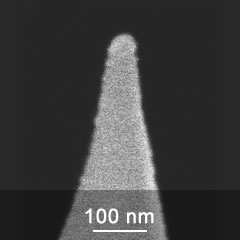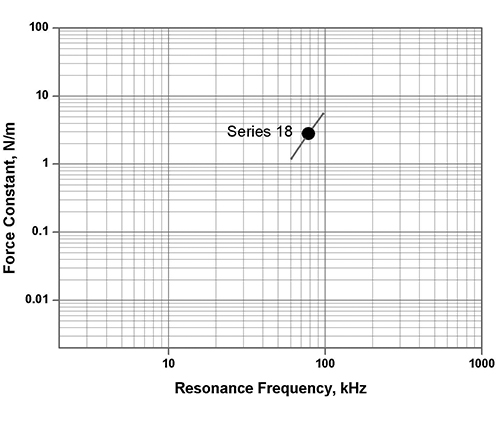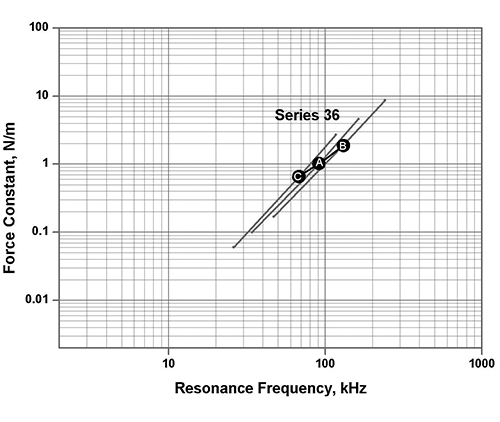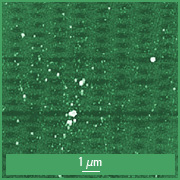Magnetic AFM Probes
-

HQ:NSC18/Co-Cr/Al BS
Magnetic Force Microscopy AFM Probe- 75 kHz 2.8 N/m
-
-
-

HQ:NSC36/Co-Cr/Al BS
Magnetic AFM Probe with 3 Different AFM Cantilevers- 60/130/65 kHz 1.0/2.0/0.6 N/m
-
-
-
Videos
-
 Co-Cr coated AFM tip close-up
Co-Cr coated AFM tip close-upTypical radius of uncoated AFM tip
8nm
Resulting AFM tip radius with the coating
<60nm
Full AFM tip cone angle
40°
Total AFM tip height
12-18µm
AFM Probe material
n-type silicon
AFM Tip coating
Magnetic
Detector coating
AluminumThe coating consists of a Co layer on the tip side of the AFM cantilever. The Co layer is formed as a polycrystalline film, which allows steady permanent magnetization in the direction of the AFM tip axis. The Co coating is protected from oxidation by a thin Cr layer, resulting in longer AFM cantilever performance. The typical coercivity Hc of the Co-Cr coating ranges from 300Oe to 400Oe.
All chips are pre-magnetized at the facility before shipping to end users. In some cases additional magnetization by an arbitrary strong magnet is required, e.g. SmCo or NdFeB.
The AFM tips have trihedral shape with a full cone angle of 40° and even smaller at the last 200nm of the AFM tip apex.
1-AFM Cantilever Series

AFM Cantilever Resonance Frequency, kHz Force Constant, N/m min typical max min typical max 18 series 60 75 90 1.2 2.8 5.5 3-AFM Cantilevers Series

AFM Cantilever Resonance Frequency, kHz Force Constant, N/m min typical max min typical max 36 series Cantilever A 30 60 160 0.1 1.0 4.6 Cantilever B 45 130 240 0.2 2 9 Cantilever C 25 65 115 0.06 0.6 2.7 Application
AFM probes with magnetic Co-Cr AFM tip coating can be used for Magnetic Force Microscopy (MFM) research. Mapping of magnetic stray field distribution to topography AFM scans can help characterize the domain structure of the magnetic materials.
The Co-Cr coating on most MFM probes creates a magnetic moment of about 10-13emu. Imaging in external magnetic field is a way to enhance the sensitivity further as it may increase the moment of both the MFM tip and the sample. Note that the magnetic structure of some samples having low coercivity (permalloy, garnet films, etc.) may be significantly affected by the magnetized Co-Cr coated AFM probe.
Though chromium provides protection for cobalt from oxidizing, magnetic AFM probes have a limited shelf life that ranges from weeks to months that depends mostly on humidity. However, there may be other reasons why AFM probes lose sensitivity. Sometimes, magnetization with an arbitrary stong magnet may help to restore the AFM probes, e.g. SmCo or NdFeB.

Height image obtained in Tapping mode. 
MFM map of the same area showing magnetic domain structure.
Height and phase images of the magnetic dipoles obtained using Co-Cr AFM cantilevers. The structure is formed in a layer of Fe0.7C0.3 by annealing with interfering laser impulses . Images are courtesy of Prof. Sheviakov (MIET, Moscow).
